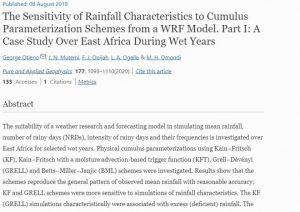Resource

The Sensitivity of Rainfall Characteristics to Cumulus Parameterization Schemes from a WRF Model. Part I: A Case Study over East Africa During Wet Years
Authors: Otieno, G., Mutemi, J. N., Opijah, F. J., Ogallo, L. A., & Omondi, M. H.
Date: 2019
Type: Journal Article
Abstract:
The suitability of a weather research and forecasting model in simulating mean rainfall, number of rainy days (NRDs), intensity of rainy days and their frequencies is investigated over East Africa for selected wet years. Physical cumulus parameterizations using Kain–Fritsch (KF), Kain–Fritsch with a moisture advection-based trigger function (KFT), Grell–Dévényi (GRELL) and Betts–Miller–Janjic (BML) schemes were investigated. Results show that the schemes reproduce the general pattern of observed mean rainfall with reasonable accuracy; KF and GRELL schemes were more sensitive to simulations of rainfall characteristics. The KF (GRELL) simulations characteristically were associated with excess (deficient) rainfall. The BML scheme simulated a double signal of wet and dry rainfall biases. The KF and GRELL schemes simulated too many (fewer) NRDs under light (heavy) rainfall categories. Using a moisture advection function in the KFT scheme potentially lowered the excess rainfall simulated in the KF scheme. The reduced wet bias in simulated rainfall is due to better explicit physical mechanism realism of the trigger function in the KF scheme. A coherent statistical difference between KF and GRELL schemes was noted. The findings provide a basis upon which researchers and forecasters can improve numerical weather systems for better forecasting and simulations of East Africa extreme rainfall characteristics.
